Greater Blue Eared Starling: Field Guide, Pictures, Habitat & Info
Last Updated on
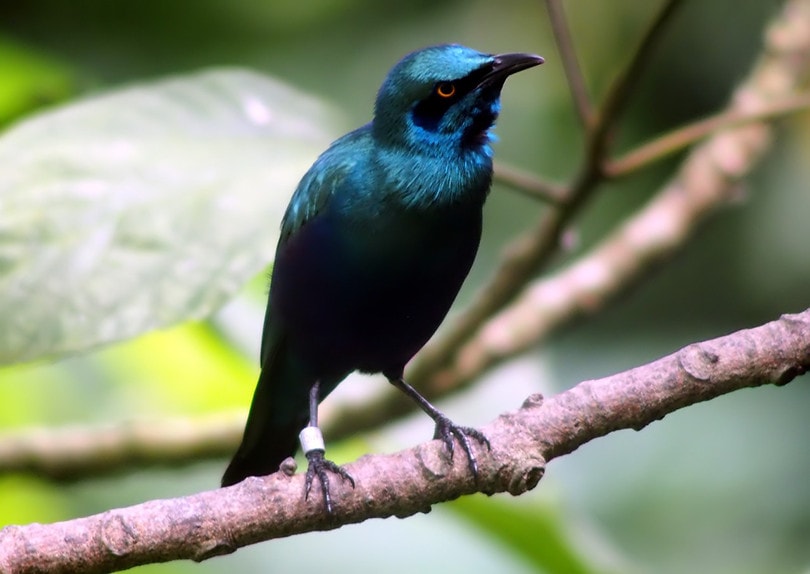
When most people think of a Starling, they picture a plain, brown bird that isn’t the most colorful in the avian world. Many are astonished when they see the Greater Blue-Eared Starling for the first time. Greater Blue-Eared Starlings have an iridescent quality to their spectacular blue-green plumage, which changes depending on how light reflects off it.
This causes confusion because Greater Blue-eared Starlings can look so different in various lighting conditions. Read on to learn about them, where they live, what they eat, and more.

Quick Facts about the Greater Blue-Eared Starling
| Habitat: | Riparian, including deciduous woodlands and dry savannahs |
| Diet: | Omnivore |
| Behavior: | Terrestrial, oviparous, large flocks |
| Nesting: | Cavities in trees and small crevices |
| Conservation: | LC (Least Concern) |
| Scientific name: | Lamprotornis chalybaeus |
| Lifespan: | 2-3 years |
Blue-Eared Starling General Description
The plumage on the Greater Blue-eared Starling is genuinely stunning, with metallic iridescent teal blue on their heads and back and a darker blue color on their lower chest and body. Greater Blue-eared Starlings have a jet-black facial patch and relatively short, thick, black bills. Topping everything off are their bright, yellow-orange eyes with large, dark pupils. Their posture is also notable, as it is more upright than most birds.
What’s truly unique about the Greater Blue-eared Starling is that the colors humans see aren’t their true colors. The keratin on their feathers splits light into different colors, changing their appearance to human eyes. One day they appear a striking teal blue, while on another, they might look turquoise green or jet black.
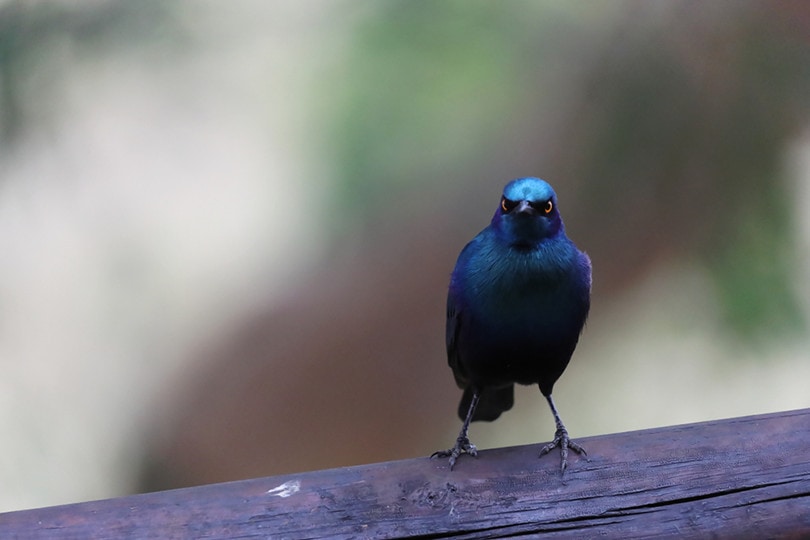
Blue-Eared Starling Range, Habitat, Behavior, Diet & Nesting
Range
Greater Blue-Eared Starlings are found almost exclusively on the African continent, mainly in the southern half. They can be found in most sub-Saharan African countries, from Angola to Zimbabwe. For the most part, Greater Blue-Eared Starlings are non-migratory, will they will travel to find a food source if necessary.
Habitat
Various habitats are home to the Greater Blue-Eared Starling, including marshlands, open woodlands, and dry savannas. You’ll also find Greater Blue-Eared Starlings in dense forests and scrublands near a dependable water source, including waterfalls and streams. The technical name for the habitat the Greater Blue-Eared Starling likes most is riparian.
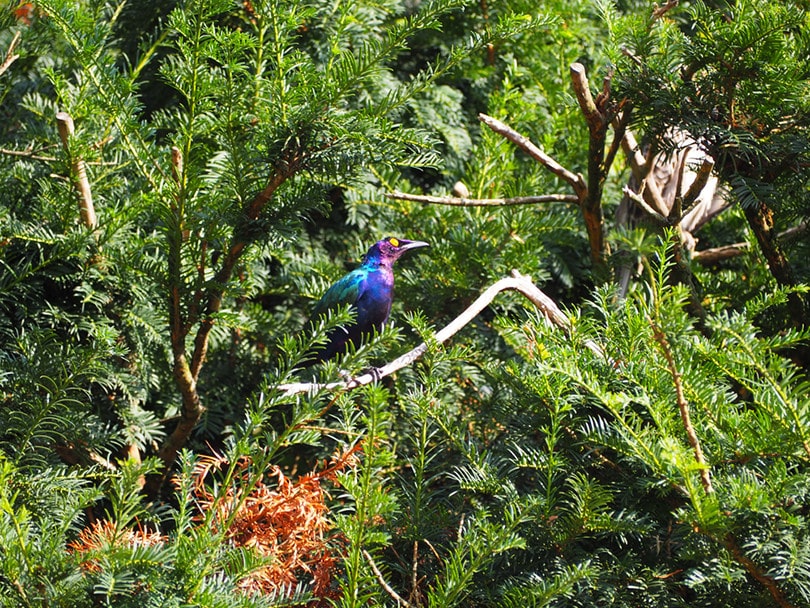
Behavior
Greater Blue-Eared Starlings are highly social birds that often gather in massive, noisy flocks, especially towards the end of the day. Their flocks often consist of other species; when a suitable location is found, all the birds will land and roost together for the night. Greater Blue-Eared Starlings will sometimes help other birds escape predators by providing camouflage. They are drawn to fig trees and agave and look for a water source they can rely on when nesting. You’ll also find them near agricultural areas where they will take advantage of the insects feeding on livestock.
Diet
The Greater Blue-Eared Starling is an omnivore, which means it eats various plants and animals. It east insects, berries, seeds, and small fruits like figs. If given the opportunity, the Greater Blue-Eared Starling will also eat small lizards and mammals, including mice. They also like to perch on the backs of large farm animals while the creatures graze and eat the fleas and ticks.
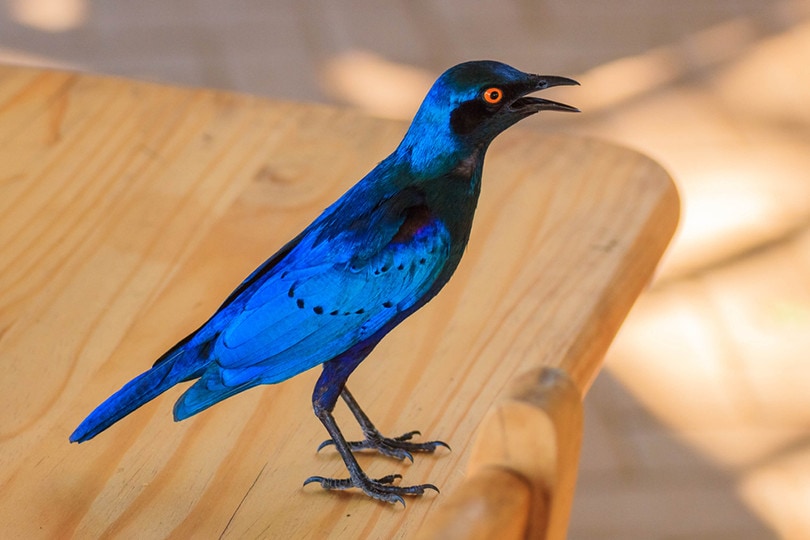
Nesting
Greater Blue-Eared Starlings look for cavities in trees, especially holes made by Woodpeckers and Barbets. They will also make their nest in the gaps found in the nest of other, larger birds like Storks and Ibises. The male and female of the species work together to make their nest, which is usually a combination of grass, feathers, and leaves. The female typically lays three to five eggs, which are a lovely blue-green color with purple and brown spots. Both parents also find and bring food to their chicks for 2 to 3 weeks until they become fledglings.

How to Find Blue-Eared Starlings: Birdwatching Tips
What to Listen For
Greater Blue-Eared Starlings are loud birds that use various calls and songs, which is why they’re so noisy when they get together in large flocks. Their calls are typically short but are difficult to define. The same can be said for their songs, which range from warbles and mews to croaks and whistles.

What to Look For
It’s difficult to miss the lovely radiance of the Greater Blue-Eared Starling, but changing light conditions can significantly alter their color. It’s best to look for a shiny, blue-green color and a bird that stands taller than most, with piecing yellow-orange eyes.
When to Look
Greater Blue-Eared Starlings feed throughout the day and can be found on the ground, in trees, and on the backs of large animals, including cows, sheep, goats, and camels, as they graze.

Attracting Blue-Eared Starlings to Your Backyard: Tips & Tricks
Plant Fig Trees
Greater Blue-Eared Starlings love figs and will gladly visit your yard if you have fig trees.
Keep livestock
Keeping cows, sheep, or goats is an excellent way to attract Greater Blue-Eared Starlings since they love to sit on their backs and eat the insects they find.
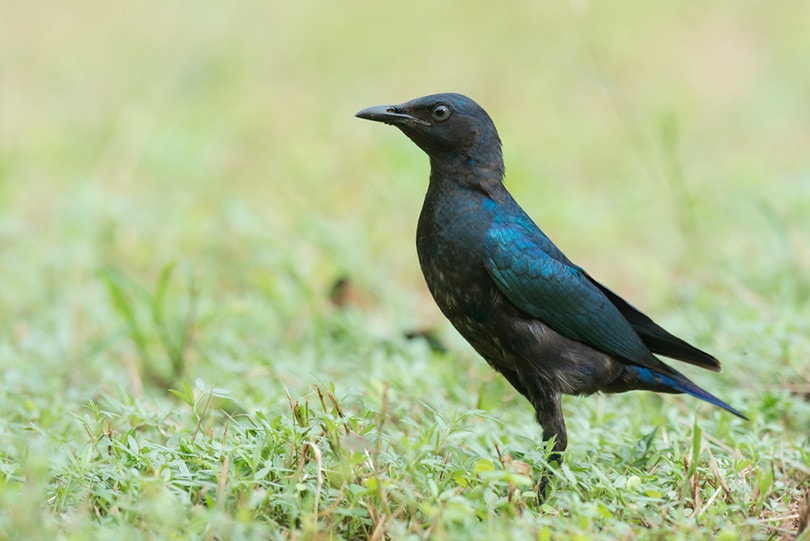
Plant Agave
Greater Blue-Eared Starlings love agave as much as figs, and maintaining several agave plants is a great way to tempt them to visit your yard.
Have a Water Source
Like all birds, Greater Blue-Eared Starlings need water. However, they seek out a reliable water source more than most birds, and having one in your backyard is essential.
Don’t Spray Insecticide
Greater Blue-Eared Starlings eat insects as their primary food source. If you kill all the insects in your yard, you remove the main reason for Greater Blue-Eared Starlings to drop by.
Blue-Eared Starling Conservation: Is this Bird Threatened?
The Greater Blue-Eared Starling is considered “least concern” (LC) and is abundant throughout the southern African continent. With agricultural activities increasing in Africa, the Greater Blue-Eared Starlings numbers are growing rather than shrinking. For example, you can see over 32,000 Greater Blue-Eared Starlings in Kruger National Park alone, and southern Mozambique has over 100,000 of the gregarious birds.

Final Thoughts
The Greater Blue-Eared Starling is an attractive species that is found almost exclusively in southern African countries. They have a wide variety of calls and songs and like to form huge flocks with other bird species, even providing protection for some. Greater Blue-Eared Starlings are abundant and can easily be spotted in their natural habitat. We hope you enjoyed our field guide and that it’s given you everything you need to find, photograph, and enjoy the lovely, lively birds!
See also:
- How Long Do Starlings Live?
- Do Starlings Eat Baby Birds?
- How to Keep Starlings from Bird Feeders
- When Do Starlings Lay Eggs?
Featured Image Credit: vinsky2002, Pixabay
Table of Contents
- Quick Facts about the Greater Blue-Eared Starling
- Blue-Eared Starling General Description
- Blue-Eared Starling Range, Habitat, Behavior, Diet & Nesting
- How to Find Blue-Eared Starlings: Birdwatching Tips
- Attracting Blue-Eared Starlings to Your Backyard: Tips & Tricks
- Blue-Eared Starling Conservation: Is this Bird Threatened?
- Final Thoughts
About the Author Greg Iacono
Greg Iacono is a self-taught writer and former chiropractor who, ironically, retired early due to back problems. He now spends his time writing scintillating content on a wide variety of subjects. Greg is also a well-known video script writer known for his ability to take a complex subject and make it accessible for the layperson.
Related Articles:
10 Types of Hummingbirds in Arkansas (With Pictures)
8 Types of Hummingbirds in Nebraska (With Pictures)
5 Types of Hummingbirds in Idaho (With Pictures)
3 Types of Hummingbirds in Mississippi (With Pictures)
8 Types of Hummingbirds in Kansas (With Pictures)
5 Types of Hummingbirds in West Virginia (With Pictures)
5 Types of Hummingbirds in Ohio (With Pictures)
Where Do Nuthatches Nest? Nuthatch Nesting Habits Explained
